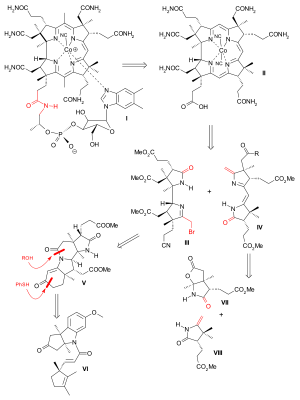Total synthesis
Total synthesis is the complete chemical synthesis of a complex molecule, often a natural product, from simple, commercially-available precursors.[1][2][3][4] It usually refers to a process not involving the aid of biological processes, which distinguishes it from semisynthesis. The target molecules can be natural products, medicinally-important active ingredients, or organic compounds of theoretical interest.
Often, the aim is to discover new route of synthesis for a target molecule for which there already exist known routes. Sometimes, however, no route exists and the chemist wishes to find a viable route for the first time. One important purpose of total synthesis is the discovery of new chemical reactions and new chemical reagents.[5]
Scope and definitions
The term total synthesis is less frequently but still accurately applied to the synthesis of natural polypeptides and polynucleotides. For instance, the peptide hormones oxytocin and vasopressin were isolated and their total syntheses were first reported in 1954.[6]
Aims
Although untrue from a historical perspective (see the history of the steroid, cortisone), total synthesis in the modern age has largely been an academic endeavour (in terms of manpower applied to problems). However, industrial concerns may pick up particular avenues of total synthesis efforts and expend considerable resources on particular natural product targets, especially if semi-synthesis can be applied to complex, natural product-derived drugs. Even so, there is a continuing discussion regarding the value of total synthesis as an academic enterprise, some aspects of which are summarised here.
Total synthesis projects often require a variety of reactions and so efforts to achieve complex total syntheses serve to prepare chemists for pursuits particularly in pharmaceutical discovery chemistry as well as in process chemistry. In both cases, comprehensive knowledge of chemical reactions and a strong and accurate chemical intuition are important qualifications.
History

Friedrich Wöhler discovered that an organic substance, urea, could be produced from inorganic starting materials in 1828. That was an important conceptual milestone in chemistry by being the first example of a synthesis of a substance that had been known only as a byproduct of living processes.[2] Wöhler obtained urea by treating silver cyanate with ammonium chloride, a simple, one-step synthesis:
- AgNCO + NH4Cl → (NH2)2CO + AgCl
Camphor was a scarce and expensive natural product with a worldwide demand. Haller and Blanc synthesized it from camphor acid;[2] however, the precursor, camphoric acid, had an unknown structure. When Finnish chemist Gustav Komppa synthesized camphoric acid from diethyl oxalate and 3,3-dimethylpentanoic acid in 1904, the structure of the precursors allowed contemporary chemists to infer the complicated ring structure of camphor. Shortly thereafter, William Perkin published another synthesis of camphor. The work on the total chemical synthesis of camphor allowed Komppa to begin industrial production of the compound, in Tainionkoski, Finland, in 1907.
The American chemist Robert Burns Woodward was a pre-eminent figure in developing total syntheses of complex organic molecules, some of his targets being cholesterol, cortisone, strychnine, lysergic acid, reserpine, chlorophyll, colchicine, vitamin B12, and prostaglandin F-2a.[2]
Vincent du Vigneaud was awarded the 1955 Nobel Prize in Chemistry for the total synthesis of the natural polypeptide oxytocin and vasopressin, which reported in 1954 with the citation "for his work on biochemically important sulphur compounds, especially for the first synthesis of a polypeptide hormone."[7]
Another gifted chemist is Elias James Corey, who won the Nobel Prize in Chemistry in 1990 for lifetime achievement in total synthesis and for the development of retrosynthetic analysis.
Examples
One classic in total synthesis is quinine total synthesis, which, before its total synthesis by Robert Burns Woodward and William von Eggers Doering in 1944,[8] had a history of many partial syntheses that spanned 150 years and included disputes and frustration.[2]
References
- "Archived copy". Archived from the original on 2014-12-20. Retrieved 2015-08-22.CS1 maint: archived copy as title (link)
- K. C. Nicolaou; D. Vourloumis; N. Winssinger and P. S. Baran (2000). "The Art and Science of Total Synthesis at the Dawn of the Twenty-First Century" (reprint). Angewandte Chemie International Edition. 39 (1): 44–122. doi:10.1002/(SICI)1521-3773(20000103)39:1<44::AID-ANIE44>3.0.CO;2-L. PMID 10649349.
- Nicolaou, K. C. & Sorensen, E. J. 1996, Classics in Total Synthesis: Targets, Strategies, Methods, New York:John Wiley & Sons, ISBN 978-3-527-29231-8
- Nicolaou, K. C. & Snyder, S. A., 2003, Classics in Total Synthesis II: More Targets, Strategies, Methods, New York:John Wiley & Sons, ISBN 978-3-527-30684-8
- Discovery of Novel Synthetic Methodologies and Reagents during Natural Product Synthesis in the Post-Palytoxin Era Ahlam M. Armaly, Yvonne C. DePorre, Emilia J. Groso, Paul S. Riehl, and Corinna S. Schindler Chem. Rev., Article ASAP doi:10.1021/acs.chemrev.5b00034
- du Vigneaud V, Ressler C, Swan JM, Roberts CW, Katsoyannis PG (1954). "The Synthesis of Oxytocin". Journal of the American Chemical Society. 76 (12): 3115–3121. doi:10.1021/ja01641a004.
- "The Nobel Prize in Chemistry 1955". Nobelprize.org. Nobel Media AB. Retrieved 17 November 2016.
- Remembering Organic Chemistry Legend Robert Burns Woodward, "C&EN", 4/10/2017